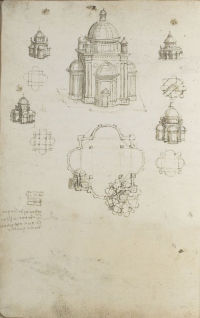Rule of Mathematics Click on the thumbnails to explore the trail
Read more about this trail (expand)
Leonardo believed that all things in nature were governed by mathematics. Mathematics was of supreme importance and expressed incontrovertible, universal truth. Knowledge of mathematics was a prerequisite for understanding the nature of all things. “Let no-one who is not a mathematician read my principles”, Leonardo said. Geometry and its actual or potential relationship to natural forms provided a suitably visual means for the exploration of mathematical “truths”.
Codex Ashburnham I and II (formerly part of Ms B (2184) and Ms A) c1492
Renaissance theorists, such as Leon Battista Alberti, loved centralised churches. They drew their inspiration from the Roman architect Vitruvius who stated in his treatise on architecture that the ideal temple had a centralised plan.
This is one of several sheets by Leonardo that illustrate designs for centrally planned churches based on circular, octagonal or polygonal plans. The larger church is based on a square plan and has a central dome and four hemispherical chapels with hemispherical domes. The tiny churches drawn to the left and right illustrate alternative designs of a similar nature, derived from different combinations of the same geometric units. All of the churches are drawn in three-dimensions from a bird’s eye view with their ground-plans drawn separately.
The minute scale, and lack of dimensions indicates that these churches were not intended to be built. In fact, they are architectural fantasies. Leonardo is exploring the creation of unique architectural forms through the combination of the same geometric units. It is a creative process that mimics the creative process of nature as Leonardo saw it, which is similarly governed by geometrical rule.
In Leonardo's words
Vitruvius the architect says in his work on architecture that the measurements of the human body are distributed by nature as follows: - that 4 fingers make 1 palm, and 4 palms make 1 foot, 6 palms makes 1 cubit; 4 cubits makes 1 pace and 24 palms makes a man; and these measures he uses in his buildings.
The Codex Ashburnham consists of an assortment of drawings and pictorial studies. The sheets were once part of manuscripts A and B, which were stolen and eventually sold to Lord Ashburnham. He returned them to the National Library in Paris in 1890.
Part II of the Codex relates solely to painting.
- Medium Pen and ink on paper
- Size 22 x 15 cm (I) and 23 x 16 cm (II)
- Location Bibliothèque de l’Institut de France











